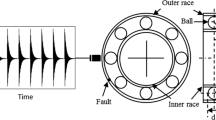Abstract
Ball bearings fault detection with the aid of ultrasound technique is of great importance. Hence, this paper evaluates signal processing of ultrasounds sent by faults and addresses relevant challenges. In this regard, the waveforms of ultrasound signals were analyzed for different types of faults and considering specification of ultrasound channels to enhance the perception of ultrasound signal processing. For this purpose, different conditions have been considered such as waveform fading and the likelihood of frequency fading at lower signal-to-noise ratios. Furthermore, the sensitivity of ultrasonic sensors to fault detection at higher frequencies and the probability of the modulation have been assessed, and modeling results have been presented. In addition to modeling, fault detection in a ball bearing of an electromotor has been studied through an industrial-empirical case study. Therefore, the bearing signals have been processed for fault-free, initial fault, and advanced fault conditions. The studied fault emerged in several months (without hand intervention) and was then intensified over time. According to results, the envelope technique is capable of extracting fault frequencies of ball bearings. Also, high-pass filters have been employed to demonstrate signal shape mode and impulse generation in detail. Moreover, it has been shown that the growth of initial faults can generate new frequencies and fault frequency harmonics other than the fault frequencies of ball bearings. Also, important tips on the ultrasound fault detection of electromotor were provided with a potential effect on the entire fault detection process. These tips came from the author’s experiences obtained by monitoring rotary machines. In which, they can serve as a beneficial tool for monitoring of such machines in industrial sites.

























Similar content being viewed by others
References
Y. Yang et al., Vibration analysis of a dual-rotor-bearing-double casing system with pedestal looseness and multi-stage turbine blade-casing rub. Mech. Syst. Signal Process. 143, 106845 (2020)
M. Zafarani, B.H. Jafari, B. Akin, Lateral and torsional vibration monitoring of multistack rotor induction motors. IEEE Trans. Ind. Electron. 68(4), 3494–3505 (2020)
K. Alewine, H. Penrose, Field experiences utilizing electrical signature analysis to detect winding and mechanical problems in wind turbine generators, in 2020 IEEE Electrical Insulation Conference (EIC) (IEEE, 2020)
B. Scheeren, M.L. Kaminski, L. Pahlavan, Evaluation of ultrasonic stress wave transmission in cylindrical roller bearings for acoustic emission condition monitoring. Sensors. 22(4), 1500 (2022)
A.L. Bowler, N.J. Watson, Transfer learning for process monitoring using reflection-mode ultrasonic sensing. Ultrasonics. 115, 106468 (2021)
C. Malla, I. Panigrahi, Review of condition monitoring of rolling element bearing using vibration analysis and other techniques. J. Vib. Eng. Technol. 7, 407–414 (2019)
A. Hemati, A. Shooshtari, Gear pump root cause failure analysis using vibrations analysis and signal processing. J. Fail. Anal. Prev. 20, 1815–1818 (2020)
G. Betta et al., A DSP-based FFT-analyzer for the fault diagnosis of rotating machine based on vibration analysis. IEEE Trans. Instrum. Meas. 51(6), 1316–1322 (2002)
A.E. Treml, R.A. Flauzino, G. Brito, EMD and MCSA improved via Hilbert transform analysis on asynchronous machines for broken bar detection using vibration analysis, in 2019 IEEE Milan PowerTech (IEEE, 2019)
Acknowledgments
I would like to thank Dr. Ebrahim Yekani Motlagh, chief manager of WAPGM Co., for his valuable financial project support. My grateful thanks are also extended to Dr. Ehsan Shabahang Nia for his valuable scientific assistance. I would also like to thank Mr. Siamak Pirmorad, former head of technical office and Mr. Vahid Hatamizadeh the current head of this office at Urmia CCPP. My deepest gratitude is for Mr. Amir Mokhtari Azar, executing manager of Urmia CCPP, and Mr. Fazel Valipour, head of maintenance department of Urmia CCPP for their support and encouragement throughout this project.
Funding
This paper is supported with West Azerbaijan Power generation Management Company. Also, all devices and instruments regarding ultrasound analysis are provided by the company of Tadbir Sazan Saramad from budget for development of Steam Power Generation units of Urmia Combined Cycle Power Plant.
Author information
Authors and Affiliations
Contributions
Ultrasound data acquisition, signal processing, modeling of ultrasound channel, and writing of this paper were performed by Hamed Mobki
Corresponding author
Ethics declarations
Conflict of interest
The author declared no potential conflicts of interest concerning the research entitled “Analysis of High Frequency Component of Ultrasound Signal for Fault Evaluation of Ball Bearing in Induction Machine,” authorship, and publication of this article.
Additional information
Publisher's Note
Springer Nature remains neutral with regard to jurisdictional claims in published maps and institutional affiliations.
Rights and permissions
Springer Nature or its licensor (e.g. a society or other partner) holds exclusive rights to this article under a publishing agreement with the author(s) or other rightsholder(s); author self-archiving of the accepted manuscript version of this article is solely governed by the terms of such publishing agreement and applicable law.
About this article
Cite this article
Mobki, H. Analysis of High Frequency Component of Ultrasound Signal for Fault Evaluation and Condition Monitoring of Ball Bearing in Induction Machine. J Fail. Anal. and Preven. 23, 2600–2622 (2023). https://doi.org/10.1007/s11668-023-01790-w
Received:
Accepted:
Published:
Issue Date:
DOI: https://doi.org/10.1007/s11668-023-01790-w




